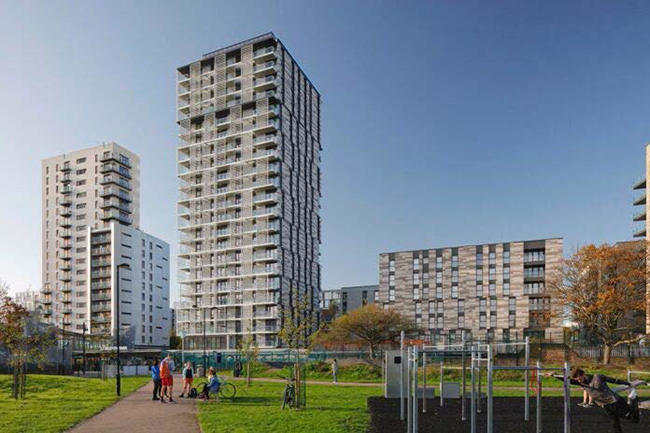7 June 20120
Setting the sustainability agenda

External of Carmen Street Build to Rent from Langdon Park
By Andrew Day, Director of Sustainability, Telford Homes
Four weeks have passed since the Government enshrined the world’s most ambitious climate change target into law, with the UK set to reduce its emissions by 78% by 2035. While this is an assertive step in the right direction, it’s also true that demand and desire from businesses, Build to Rent investors and consumers, to establish sustainable assets and ways of living, is accelerating at an exponential rate. Some 74% of local authorities have declared a Climate Emergency, with many setting additional net zero policy objectives in advance of the government’s national target.
Now is the time for the housebuilding sector to act with an integrated vision. With the housing crisis driving demand for affordable homes and cohesive social infrastructure, the industry has this opportunity to deliver new climate resilient places and sustainable homes at pace. Combined with the impacts of the Covid-19 pandemic and Brexit, it is important to continue to prioritise sustainability policies, related regulations with purpose – we believe our strategy: Building a Living Legacy, provides this platform.
The introduction of the ambitious Future Home Standard from 2025 will greatly assist the sector in rising to meet these challenges. Yet as a responsible business, Telford Homes decided to act sooner. Last year, we became the first housebuilder to set out an integrated sustainability roadmap for the decade – culminating in the ambitious target of becoming a net-zero carbon company by 2030. This strategy informs our mission, improves the environment and wellbeing of our customers, and supports our aim to be a partner and employer of choice.
As the net zero objective draws closer, here are five ways the housebuilding sector can adopt and transform together:
- Truly integrated strategies – collective efforts between the industry, policy-makers and like-minded advocacy groups, such as the development of a deliverable National Future Homes Standard, will be vital. We must continue to take forward learnings and adopt best practice with the Home Builders Federation, UKAA and the UK-Green Building Council, importantly with the customer at the centre of our strategies.
- The adoption of clear, consistent metrics – the only way to effectively measure outputs is through creditable and uniform approaches such as the adoption of Science Based Targets and TCFD reporting. We believe that setting greenhouse gas emissions targets in line with climate science is a robust way to drive innovation to future proof the business. We encourage the support of the NextGeneration Sustainability benchmarking of the UK 25 largest housebuilders. This assessment compares peers against 15 criterions ranging from strategy & governance through to economic development.
- Implement strong governance – everybody has a part to play in reducing environmental impacts, and it is vital that businesses make ESG a boardroom priority. To do this effectively, sustainability aspects must be included in business, executive and staff personal objectives and in training programmes.
- Partner with like-minded supply chains – adjusting to the climate challenge will impactall areas of the industry. Supporting innovative supply chains, new procurement processes, materials, and the investment in smart technologies, will add social value through the project lifecycle, and improve the customer experience as we transition to OPEX models.
- Balanced resources – explore ways of designing out emissions and damaging impacts across business operations and actively migrate towards the use of greener optioneering. For example, use electricity to heat homes through air or ground source pumps, aligning with the decarbonisation of electricity production. Furthermore, lessening the embodied CO2 impact of materials that we specify, by potentially procuring more onshore and nearshore commodities.
Now is the time for business and society to reset and look to the future. Intrinsically the Build to Rent sector has the potential to deliver great places, accelerate its citizenship agenda – to inform a better quality of life for future generations and implement a Build Back Better vision.

